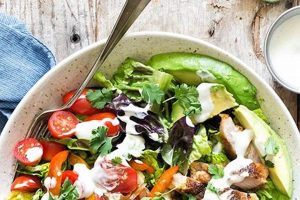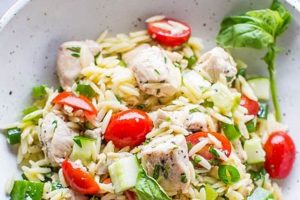A Caesar salad featuring grilled chicken typically includes romaine lettuce, croutons, Parmesan cheese, and a creamy Caesar dressing. The chicken, grilled to enhance its flavor and texture, adds a substantial protein element to this classic dish. Variations may involve different herbs, spices, or additions to the dressing, such as anchovies or lemon juice. An example might include grilled chicken marinated in lemon-herb seasoning, served atop romaine lettuce with homemade croutons, shaved Parmesan, and a creamy dressing made with garlic, Dijon mustard, and Worcestershire sauce.
Adding grilled poultry to this salad offers nutritional value and a satisfying heartiness. The grilling process can impart smoky flavors, enhancing the overall culinary experience. While the original Caesar salad did not include chicken, its addition reflects evolving culinary preferences and the desire for a more complete meal. This adaptation has become a staple in restaurants and homes, appreciated for its balanced combination of protein, vegetables, and flavorful dressing.
The following sections will explore various aspects of creating this popular dish, including selecting and preparing the chicken, making croutons and dressing from scratch, and assembling the salad for optimal presentation and flavor.
Tips for a Superior Caesar Salad with Grilled Chicken
Achieving a truly exceptional Caesar salad with grilled chicken involves attention to detail in every step, from selecting ingredients to final presentation. These tips offer guidance for elevating this classic dish.
Tip 1: Marinate the Chicken: Marinating the chicken, even briefly, adds significant depth of flavor. A simple marinade of olive oil, lemon juice, garlic, and herbs can transform the final dish.
Tip 2: Grill Chicken to Perfection: Proper grilling technique ensures juicy, flavorful chicken. Aim for an internal temperature of 165F (74C) to ensure food safety without overcooking.
Tip 3: Make Croutons from Scratch: Homemade croutons offer superior texture and flavor compared to store-bought alternatives. Use day-old bread, cubed and tossed with olive oil and seasonings, then baked or pan-fried until golden brown.
Tip 4: Emulsify the Dressing Properly: A properly emulsified Caesar dressing is creamy and cohesive. Slowly whisk in the oil to the egg yolks and other ingredients to achieve the desired consistency.
Tip 5: Use High-Quality Parmesan Cheese: Freshly grated Parmesan cheese offers a richer, more complex flavor profile that significantly enhances the salad.
Tip 6: Don’t Overdress the Salad: Add dressing gradually, tossing gently to coat the leaves evenly. Too much dressing can make the salad soggy and overwhelm the other flavors.
Tip 7: Assemble Just Before Serving: To maintain the crispness of the lettuce and croutons, assemble the salad immediately before serving. This prevents the components from becoming wilted or soggy.
By following these guidelines, one can create a Caesar salad with grilled chicken that surpasses expectations, offering a delightful balance of flavors and textures.
These techniques, while straightforward, contribute significantly to a more refined and enjoyable dining experience.
1. Grilled Chicken
Grilled chicken serves as the central protein component in a grilled chicken Caesar salad recipe. Its inclusion transforms the traditional Caesar salad from a lighter fare into a more substantial and complete meal. The grilling process imparts a distinctive smoky char and enhances the inherent flavors of the chicken, adding depth and complexity to the salad. The method of grilling also influences the final result. Direct grilling over high heat creates a crisp exterior and juicy interior, while indirect grilling allows for slower cooking, suitable for larger pieces or bone-in chicken. The choice depends on the desired outcome and available equipment. For example, using a gas grill allows for precise temperature control, while charcoal grilling imparts a more intense smoky flavor.
The quality and preparation of the grilled chicken directly impact the overall success of the salad. Proper marinades not only tenderize the meat but also infuse it with complementary flavors that enhance the other ingredients. A marinade with citrus, herbs, and garlic, for instance, can brighten the salad’s flavor profile. Furthermore, achieving the correct internal temperature during grilling is crucial for both food safety and optimal palatability. Overcooked chicken can become dry and tough, detracting from the overall dining experience. Conversely, undercooked chicken poses health risks. Achieving a balance between these extremes ensures a safe and delicious culinary outcome.
The inclusion of grilled chicken in the Caesar salad exemplifies the evolution of culinary traditions, adapting to changing tastes and dietary preferences. While the original Caesar salad did not contain meat, the addition of protein reflects a modern desire for more balanced and satisfying meals. Understanding the role and impact of the grilled chicken within this context allows for informed choices regarding preparation methods, flavor profiles, and the overall balance of the final dish. Achieving mastery over this element elevates the grilled chicken Caesar salad from a simple dish to a truly satisfying culinary experience.
2. Crisp Romaine
Crisp romaine lettuce forms the foundation of a successful grilled chicken Caesar salad. Its structural integrity provides a refreshing counterpoint to the richness of the grilled chicken and the creamy dressing. The crisp texture offers a satisfying crunch, enhancing the overall sensory experience. Wilt or limp lettuce detracts significantly from the salad’s appeal, affecting both presentation and enjoyment. The inherent slightly bitter flavor of romaine complements the other ingredients, balancing the richness of the chicken and the tanginess of the dressing. Using other lettuce varieties, such as iceberg or butter lettuce, while possible, alters the classic flavor profile and textural experience of a true Caesar salad. For instance, iceberg lettuce, while crisp, lacks the subtle bitterness and structural robustness of romaine, resulting in a less satisfying dish.
Maintaining romaine’s crispness requires careful handling and storage. Washing and thoroughly drying the leaves before assembling the salad prevents premature wilting. Storing the lettuce in a cool, dry environment, preferably in a perforated container or wrapped in paper towels, helps preserve its freshness. Adding the dressing only immediately before serving further protects the lettuce from becoming soggy. Consider the impact of temperature fluctuations on the lettuce; significant temperature changes can accelerate wilting. Practical applications of this understanding include refrigerating the lettuce until just before preparation and assembling the salad as close to serving time as possible. These practices maintain the desirable crispness essential for a high-quality salad.
The crispness of romaine lettuce is not merely a desirable characteristic but a crucial element in a grilled chicken Caesar salad. Its structural integrity, textural contrast, and complementary flavor profile contribute significantly to the overall culinary experience. Challenges such as maintaining crispness during preparation and storage can be addressed through proper handling techniques. Recognizing the importance of crisp romaine underscores its essential role in this classic dish.
3. Creamy Dressing
Creamy dressing forms an integral part of a grilled chicken Caesar salad recipe, binding the components and contributing a rich, tangy flavor profile. The emulsion, traditionally made with egg yolks, oil, lemon juice, garlic, and seasonings, provides a luxurious mouthfeel that complements the crisp romaine and savory grilled chicken. This creamy element acts as a unifying force, coating the ingredients and delivering a burst of flavor with each bite. The quality of the dressing significantly impacts the overall dining experience; a poorly emulsified or bland dressing can detract from the salad’s appeal. For example, a dressing that is too thin will fail to adhere properly to the lettuce, while a dressing that is too thick can overwhelm the other flavors. The balance of tanginess, richness, and savory notes within the dressing is essential for achieving a harmonious flavor profile.
Variations in dressing recipes can introduce nuanced flavor complexities. The addition of ingredients like anchovies, Dijon mustard, Worcestershire sauce, or Parmesan cheese contributes depth and intensity to the classic Caesar dressing. These additions can be tailored to complement the specific flavor profile of the grilled chicken. For instance, a lemon-herb marinated chicken might pair well with a dressing featuring a hint of Dijon mustard, while a smoky, paprika-rubbed chicken could benefit from the addition of anchovies to the dressing. The interplay of flavors between the chicken and the dressing enhances the overall culinary experience, moving beyond mere satisfaction to a more nuanced and delightful interaction of tastes.
Achieving the proper consistency and flavor balance in the creamy dressing is crucial for a successful grilled chicken Caesar salad. Challenges such as over- or under-emulsification can be addressed through careful technique and attention to detail during preparation. The dressings role extends beyond merely coating the ingredients; it acts as a flavor enhancer and a unifying element, bringing together the disparate components into a cohesive and satisfying whole. Understanding the importance of the creamy dressing within the broader context of the recipe allows for informed choices regarding ingredient selection, preparation methods, and flavor pairings, ultimately resulting in a more elevated culinary outcome.
4. Crunchy Croutons
Crunchy croutons contribute a vital textural element to the grilled chicken Caesar salad, providing a satisfying contrast to the crisp romaine, tender grilled chicken, and creamy dressing. Their presence elevates the salad from a simple combination of ingredients to a more complex and engaging culinary experience. The quality and characteristics of the croutons significantly influence the overall perception of the dish.
- Texture and Crispness
The primary role of croutons is to introduce a contrasting textural element. Their crispness offers a satisfying counterpoint to the softer textures of the other ingredients. Achieving optimal crispness often involves using day-old bread, which contains less moisture. The toasting or frying process further dehydrates the bread, resulting in a satisfying crunch. Soggy or stale croutons detract from the desired textural interplay, diminishing the overall enjoyment of the salad. Consider the difference between a freshly made crouton with a robust crunch and a store-bought crouton that has lost its crispness due to exposure to air; the former enhances the salad, while the latter detracts from it.
- Flavor Enhancement
Croutons offer an opportunity to introduce additional flavors that complement the other components of the salad. Tossing the bread cubes with olive oil, herbs, spices, or garlic powder before baking or frying infuses them with complementary flavors. These added flavors can enhance the overall complexity of the salad, creating a more nuanced and satisfying taste experience. For example, croutons seasoned with garlic and herbs can complement a lemon-herb marinated grilled chicken, while croutons seasoned with Parmesan cheese can enhance the savory notes of the dressing.
- Bread Selection and Preparation
The type of bread used for croutons impacts both texture and flavor. A sturdy, slightly dense bread, such as a baguette or ciabatta, holds its shape well and provides a satisfying crunch. Using softer breads can result in croutons that are too delicate or that absorb excessive dressing, becoming soggy. The method of preparation, whether baking or pan-frying, also influences the final result. Baking typically produces a more evenly toasted crouton, while pan-frying can achieve a richer, more browned exterior. Each method offers distinct advantages depending on the desired outcome and available equipment.
- Balance and Proportion
The quantity of croutons in the salad should be carefully considered to maintain a balanced composition. Too few croutons can leave the salad feeling incomplete, while too many can overwhelm the other ingredients, both texturally and visually. Achieving the right balance ensures that the croutons enhance the salad without dominating it. This balance allows the other elements, such as the grilled chicken and romaine lettuce, to retain their prominence within the dish. The visual appeal of the salad is also enhanced by the considered placement of croutons.
The carefully considered integration of crunchy croutons into a grilled chicken Caesar salad elevates the dish from a simple combination of ingredients to a more refined and satisfying culinary experience. By understanding the interplay of texture, flavor, and proportion, one can optimize the contribution of croutons, ensuring they play their intended role in enhancing the overall enjoyment of the salad. The seemingly simple crouton becomes a significant component in the carefully orchestrated symphony of flavors and textures that define a well-made grilled chicken Caesar salad.
5. Parmesan Cheese
Parmesan cheese plays a crucial role in a grilled chicken Caesar salad, contributing a sharp, salty, and umami-rich flavor profile that balances the other components. Its hard texture provides a pleasant contrast to the crisp romaine, tender chicken, and creamy dressing. Authentic Parmigiano-Reggiano, with its complex crystalline structure, offers a more intense flavor experience compared to generic Parmesan cheeses. This distinction arises from specific production methods and aging processes. The crystalline structure affects the cheese’s texture and contributes to its unique flavor profile. Using a high-quality Parmesan elevates the overall culinary experience. For instance, freshly grated Parmigiano-Reggiano, with its nutty and slightly salty notes, enhances the creamy dressing and complements the savory grilled chicken more effectively than pre-grated or lower-quality Parmesan.
The aging process of Parmesan significantly influences its flavor and texture. Longer aging periods, typically 24 to 36 months, result in a more complex and pronounced flavor profile, characterized by sharper, nuttier, and slightly sweet notes. This complexity adds depth to the salad, counterbalancing the richness of the dressing and the savory chicken. Furthermore, the texture of aged Parmesan becomes harder and more granular, which contributes to the desirable textural contrast within the salad. Understanding these nuances allows for informed choices when selecting Parmesan for this specific application. Consider a scenario where a milder, younger Parmesan might be chosen for a salad featuring delicate herbs and a lighter dressing, while a more mature, aged Parmesan might be preferred for a salad with bolder flavors, such as smoky grilled chicken and a robust dressing.
The careful selection and application of Parmesan cheese significantly influence the overall balance and complexity of a grilled chicken Caesar salad. Recognizing the impact of quality, age, and texture allows for informed choices that enhance the final dish. Challenges, such as preventing the cheese from clumping or ensuring even distribution throughout the salad, can be addressed through proper grating techniques and careful assembly. Integrating high-quality Parmesan cheese into the salad not only enhances its flavor profile but also demonstrates an attention to detail that elevates the entire dining experience. The Parmesan, while a seemingly simple ingredient, becomes a critical component in the carefully orchestrated balance of flavors and textures that define a well-executed grilled chicken Caesar salad.
6. Flavor Balance
Flavor balance constitutes a critical aspect of a successful grilled chicken Caesar salad recipe. The dish relies on a harmonious interplay of contrasting yet complementary flavors. Savory elements from the grilled chicken, particularly when enhanced by marinades or rubs, provide a foundation. These savory notes interact with the tangy acidity of the Caesar dressing, traditionally composed of lemon juice, garlic, and Worcestershire sauce. The crisp, slightly bitter romaine lettuce offers a refreshing counterpoint, preventing the richer elements from becoming overwhelming. Crunchy croutons introduce textural variation and subtle toasted notes, depending on their seasoning. Finally, the sharp, salty, and umami notes of Parmesan cheese provide a unifying element, tying the diverse flavors together. A well-balanced Caesar salad avoids any single flavor dominating the others, resulting in a cohesive and satisfying culinary experience. An imbalance, such as an overly acidic dressing or excessively salty cheese, can disrupt this harmony and detract from the overall enjoyment.
Consider a scenario where the grilled chicken is marinated in a lemon-herb mixture. This marinade introduces bright citrus notes and herbal complexities to the chicken, which then interact with the tangy Caesar dressing. If the dressing also contains a significant amount of lemon juice, the resulting salad might become excessively acidic. To achieve balance, one might adjust the dressing’s acidity or choose a different marinade for the chicken. Alternatively, incorporating a sweeter element, such as a touch of honey or maple syrup in the dressing, could temper the overall acidity. Similarly, the saltiness of the Parmesan cheese needs careful consideration. An excessively salty cheese can overwhelm the other flavors, while insufficient saltiness can leave the salad tasting bland. Achieving the right balance ensures that each ingredient contributes to the overall flavor profile without dominating the others.
Understanding the interplay of flavors within a grilled chicken Caesar salad enables informed decision-making regarding ingredient selection and preparation. Recognizing the potential for imbalances allows for proactive adjustments, ensuring a harmonious final product. This understanding extends beyond mere recipe adherence to a deeper appreciation of culinary principles. Successfully balancing flavors elevates the dish from a simple combination of ingredients to a nuanced and satisfying culinary experience, demonstrating a mastery of flavor composition. This careful orchestration of tastes transforms a familiar dish into something truly exceptional.
Frequently Asked Questions
This section addresses common inquiries regarding the preparation and enjoyment of grilled chicken Caesar salad.
Question 1: What is the best way to prevent grilled chicken from drying out in a Caesar salad?
Marinating the chicken before grilling helps retain moisture. A proper marinade not only adds flavor but also tenderizes the meat, contributing to a juicier final product. Additionally, avoiding overcooking is crucial. Using a meat thermometer ensures the chicken reaches a safe internal temperature of 165F (74C) without becoming dry.
Question 2: Can other types of lettuce be used in a Caesar salad besides romaine?
While romaine is traditional, other lettuces can be substituted. However, variations in flavor and texture will occur. Alternatives like green leaf or butter lettuce offer a milder flavor, while iceberg lettuce provides a different textural experience. These substitutions deviate from the classic Caesar salad profile but offer options for individual preferences.
Question 3: How can one achieve a creamy Caesar dressing without using raw eggs?
Several alternatives to raw eggs exist for achieving a creamy dressing. Pasteurized egg yolks eliminate concerns regarding raw egg consumption. Other options include using mayonnaise, Greek yogurt, or mashed avocado as a base for the dressing. These alternatives offer similar creamy textures while accommodating dietary restrictions or preferences.
Question 4: What are the best methods for making homemade croutons?
Homemade croutons offer superior flavor and texture compared to store-bought varieties. Cubing day-old bread and tossing it with olive oil and seasonings before baking or pan-frying creates flavorful, crispy croutons. Baking provides a more even toast, while pan-frying allows for greater control over browning and crispness.
Question 5: How can one prevent a Caesar salad from becoming soggy?
Sogginess often results from premature dressing or improper lettuce storage. To prevent this, assemble the salad just before serving. Thoroughly dry the lettuce after washing and store it in a cool, dry place. Adding the dressing only at the last minute prevents the lettuce from wilting and the croutons from becoming soggy.
Question 6: What are some suitable variations or additions to a classic grilled chicken Caesar salad?
Classic recipes offer a versatile base for customization. Adding ingredients like cherry tomatoes, Kalamata olives, or avocado introduces additional flavors and textures. Variations in the marinade for the chicken or the ingredients in the dressing, such as incorporating different herbs, spices, or cheeses, further personalize the salad, catering to individual preferences.
Addressing these common questions provides a deeper understanding of the nuances involved in creating a successful grilled chicken Caesar salad. Attention to detail in each step, from ingredient selection to final assembly, ensures a satisfying and enjoyable culinary experience.
Further exploration of specific techniques and variations will be provided in the following sections.
Grilled Chicken Caesar Salad Recipe
Exploration of the grilled chicken Caesar salad recipe reveals a dish greater than the sum of its parts. Careful consideration of individual componentsgrilled chicken, crisp romaine, creamy dressing, crunchy croutons, and Parmesan cheesedemonstrates the importance of ingredient quality and preparation techniques. Balance emerges as a central theme, highlighting the interplay of flavors and textures. From the savory char of the grilled chicken to the tangy dressing and the crisp romaine, each element contributes to a cohesive and satisfying whole. Mastery of these elements elevates the dish beyond a simple salad, transforming it into a carefully orchestrated culinary experience.
The continued evolution of culinary traditions allows for adaptation and personalization. While adherence to classic principles provides a foundation, individual preferences and creative exploration can further enhance this versatile dish. The grilled chicken Caesar salad, when thoughtfully prepared, offers a testament to the enduring appeal of fresh ingredients and balanced flavors. Culinary exploration extends beyond mere sustenance; it represents a continuous journey of discovery and refinement, a testament to the power of food to nourish and delight.






